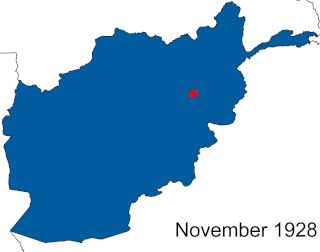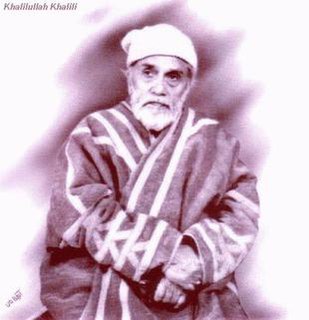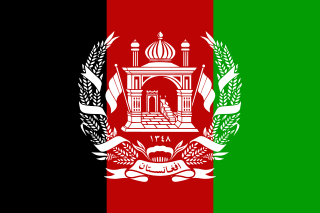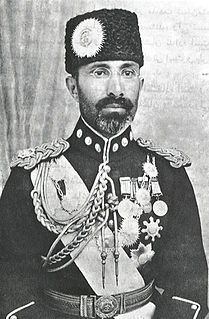
The Afghan Civil War was fought from 14 November 1928 to 13 October 1929. Rebelling, and subsequently governing Saqqawist forces under Habibullāh Kalakāni fought against various opposing tribes and rival monarchs in the Kingdom of Afghanistan, among whom Mohammed Nādir Khān eventually achieved a preponderant role. Despite early successes, such as the capture of Kabul and defeat of Amanullah Khan on 17 January 1929 or the capture of Kandahar on 3 June, the Saqqawists were eventually deposed by anti-Saqqawist forces led by Nadir on 13 October 1929, leading to Nadir's ascension as King of Afghanistan, who ruled until his assassination on 3 November 1933.

Pashtūnistān is the geographic historical region inhabited by the indigenous Pashtun people of modern-day Afghanistan and Pakistan in South-Central Asia, wherein Pashtun culture, language, and national identity have been based. Alternative names historically used for the region include "Pashtūnkhwā" (پښتونخوا) and "Afghānistān" (افغانستان), since at least the 3rd century CE onward. Pashtunistan borders Iran to the west, Persian and Turkic-speaking areas of Turkestan region to the north, Kashmir to the northeast, Punjab to the east, and Balochistan to the south.

Ghāzī Amānullāh Khān was the sovereign of the Kingdom of Afghanistan from 1919 to 1929, first as Emir and after 1926 as King. After the August 1919 end of the Third Anglo-Afghan War, Afghanistan was able to relinquish from a protected state status to proclaim independence and pursue an independent foreign policy free from the influence of the United Kingdom.

Habibullāh Kalakāni, also known by his nickname "Bacha-ye Saqao" was a ruler of Afghanistan from 17 January to 13 October 1929, as well as a leader of the Saqqawists. During the Afghan Civil War, he captured vast swathes of Afghanistan and ruled Kabul during what is known in historiography as the "Saqqawist period". He was an ethnic Tajik. No country recognized Kalakani as ruler of Afghanistan.

Faiz Mohammad Kātib Hazāra most known as Kātib was son of Saeed Mohammad was born in 1860, in Zard Sang village of Nawur Distric of Ghazni Province of Afghanistan, he spent a part of his life in Nawur District another district of Ghazni, and died in Kabul on March 3, 1931. He was an ethnic Hazara and was of Muhammad Khwaja Hazara clan. He was Afghan court chronicler, a skilled calligrapher and secretary to Emir Habib Ullah Khan from 1901 to 1919. He was a well known historian, writer and intellectual, among the renowned group of Afghans seeking social and political changes in the country at the beginning of the 20th century, which shaped early regional politics from Afghanistan to Morocco therefore many of the Afghan people say the government should have named him as the Father of Afghanistan History. He was a member of what became known as Junbish-i Mashrutyat or The Constitutionalist Movement.

Qarabagh District is located 50 kilometers north of Kabul City in Afghanistan, and 20 kilometers southeast of Bagram Airbase. The district is part of Kabul Province and is on the route between Kabul and Parwan Province. It has a population of 15,000, with an expected 19,000 more people to return from Pakistan and Iran in the future. As of 2002 around 60% of the population are Tajiks and 40% Pashtuns.

Khalilullah Khalili was Afghanistan's foremost 20th century poet as well as a noted historian, university professor, diplomat and royal confidant. He was the last of the great classical Persian poets and among the first to introduce modern Persian poetry and Nimai style to Afghanistan. He had also expertise in Khorasani style and was a follower of Farrukhi Sistani. Almost alone among Afghanistan's poets, he enjoyed a following in Iran where his selected poems have been published. His works have been praised by renowned Iranian literary figures and intellectuals. Many see him as the greatest contemporary poet of the Persian language in Afghanistan. He is also known for his major work "Hero of Khorasan", a controversial biography of Habībullāh Kalakānī, Emir of Afghanistan in 1929.

Deh Sabz District is situated northeast of Kabul City in Afghanistan. It has a population of 100,136 people. About 70% are Pashtuns and 30% are Tajiks.

Guldara District is located in the northwestern part of Kabul Province, Afghanistan. It has a population of 25,213 people, including new returnees. Around 70% are Tajiks and 30% Pashtuns.

Mir Bacha Kot District is situated in the central part of Kabul Province, Afghanistan. It has a population of 5,000 and another 37,000 are expected to return in the near future. Tajiks are the majority and some Pashtuns also live there.
The Farza District is a new district of Kabul Province, Afghanistan, with a population of 18,000 people. Farza is one of the greenest districts of Kabul. Two hundred years ago the people of Farza had a kingdom lifestyle. The center of Farza is called Qala Mera, which was made by Sayed Baabshah. Sayed's people had strong rules and they were peaceful people.
Habibullah also spelled Habib Ullah, Habibollah, Habeeb-Allah etc., is a male Muslim given name meaning in Beloved of God, stemming from the male form of the name Habib. It may refer to:
The following lists events that happened during 1929 in Afghanistan. The Afghan Civil War continued from the previous year.
The Mangal is a Pashtun tribe, residing in eastern Paktia and adjacent Khost provinces of Afghanistan, and in the town of Tari Mangal, district Kurram, Pakistan. Their land constitutes the northeastern part of the Loya Paktia region. The Mangals descent from Karlani Pashtun lineage.

The Kingdom of Afghanistan was a constitutional monarchy in Southern and Central Asia established in 1926 as a successor state to the Emirate of Afghanistan. It was proclaimed by its first king, Amanullah Khan, seven years after his accession to the throne. The monarchy ended in the 1973 Afghan coup d'état.

Muhammad Nadir Shah was King of Afghanistan from 15 October 1929 until his assassination in November 1933. Previously, he served as Minister of War, Afghan Ambassador to France, and as a general in the military of Afghanistan. He and his son Muhammad Zahir Shah, who succeeded him, are part of the Musahiban.
Starting in the 1880s, various Pashtun-dominated governments of Afghanistan have pursued policies, called Pashtunization aimed towards settling more ethnic Pashtuns in the northern region of Afghanistan.

The Saqqawists were an armed group in the Kingdom of Afghanistan who were active from the 1924 to 1931. They were led by Habibullāh Kalakāni, and in January 1929 they managed to take control of the capital of Afghanistan, Kabul, establishing the Emirate of Afghanistan. Following military reversals in the Afghan Civil War (1928–1929), they were forced out of the capital in October 1929. Saqqawist activity ended in 1931.

The Emirate of Afghanistan was an unrecognized state ruled by the Saqqawists that existed from January to October 1929. Habibullāh Kalakāni became the state's only emir on 18 January 1929. After the fall of Kalakani on 13 October 1929, the Emirate ended.














